Tuesday, November 15th 2011

ASUS Ready with Rampage IV Formula; Rampage IV Gene in the Pipeline
This week, ASUS, along with the rest of the PC motherboard industry, launched its socket LGA2011 board lineup, with its three main lines: P9X79, ROG Rampage IV, and TUF Sabertooth X79. The ROG line included the Rampage IV Extreme, which ended up being ASUS' flagship socket LGA2011 motherboard for the platform's launch. It's filled to the brim with all the features gamers and overclockers will ever need. But as with most ROG lines, Rampage IV will have a complete triad: Extreme (already launched), Formula (a notch below Extreme, but still offers great features), and Gene (Micro-ATX, stuffed with features).
Press shots and presentation slides of the Rampage IV Formula started making waves today. Pictures reveal the board to be standard ATX. Unlike the Extreme, Formula has just four DDR3 DIMM slots (one slot per memory channel), yet it supports all the DRAM multipliers Extreme does. The CPU is powered by a 11-phase Digi+ VRM. It is wired to four PCI-Express 3.0 (capable) x16 slots, among which two are PCI-Express 3.0 x16 capable, and all four are x8 capable, depending on the way they are populated with addon cards. Apart from these long slots, there are two PCI-E 2.0 x1. 4-way SLI and CrossFireX are supported. Storage connectivity includes four SATA 3 Gb/s (black), four SATA 6 Gb/s (red, two from the PCH, two from third-party controller), and two eSATA 6 Gb/s (also from a third-party controller).ASUS deployed a new audio solution on this board, putting its experience with audiophile-grade sound cards to 'sound' use. The board features what's called ASUS SupremeFX III. It combines a new conventional high signal-noise ratio (high-quality/fidelity) HD Audio CODEC (probably ALC898), with an active circuit that works to eliminate EMI noises commonly found on motherboards. The circuit consists of a 1500 uF capacitor that works to dampen EMI noises, the CODEC chip is covered with an EMI shield, and the area where the CODEC is located is electrically isolated from the rest of the board. At the analog output cluster, the audio jacks are gold-plated. As a neat cosmetic touch, ASUS used its PCB printer to lay a fiber-optic trace like a wire on the topmost PCB layer, at one of its ends is a blood-red LED, this wire ends up looking a a groovy red line connecting the CODEC to the audio jack cluster and front-panel HDA header, and a glowing ROG "eye" logo. Again, this is a purely cosmetic touch.There is one Ethernet connection, driven by an Intel-made controller. There are six USB 3.0 ports, four on the rear panel, two via header. A bunch of USB 2.0 and PS/2 combo make for the rest of the rear panel. Here, you will also find ROG connect and CMOS clear switches (can be disabled), and a BIOS flashback button that helps the UEFI BIOS recover from bad settings/flashes. It's basically a panic button.
ROG exclusives include a feature-rich ROG UEFI firmware setup program, TweakIT, ProbeIT, LN2-safe mode, Voltiminder, onboard OC switches, ROG Connect, ROG Flashback, ROG Gamefirst, and XSocket. XSocket is a unique CPU socket retention clip custom-made by ASUS, which lets you use any socket LGA1366-supporting cooler or water-block on the LGA2011 socket. Expect the ASUS Rampage IV Formula to have a sweet price.Rampage IV Gene
ASUS announced Rampage IV Gene to its internal partners (and not to the general public), it is a micro-ATX motherboard for the LGA2011 platform, though it didn't talk about it much. In fact the slide detailing it had its picture blurred, and used the wrong picture for Rampage IV Formula picture. We'll try to find out more about this board in the coming days.
Sources:
SweClockers, Maximum Tech
Press shots and presentation slides of the Rampage IV Formula started making waves today. Pictures reveal the board to be standard ATX. Unlike the Extreme, Formula has just four DDR3 DIMM slots (one slot per memory channel), yet it supports all the DRAM multipliers Extreme does. The CPU is powered by a 11-phase Digi+ VRM. It is wired to four PCI-Express 3.0 (capable) x16 slots, among which two are PCI-Express 3.0 x16 capable, and all four are x8 capable, depending on the way they are populated with addon cards. Apart from these long slots, there are two PCI-E 2.0 x1. 4-way SLI and CrossFireX are supported. Storage connectivity includes four SATA 3 Gb/s (black), four SATA 6 Gb/s (red, two from the PCH, two from third-party controller), and two eSATA 6 Gb/s (also from a third-party controller).ASUS deployed a new audio solution on this board, putting its experience with audiophile-grade sound cards to 'sound' use. The board features what's called ASUS SupremeFX III. It combines a new conventional high signal-noise ratio (high-quality/fidelity) HD Audio CODEC (probably ALC898), with an active circuit that works to eliminate EMI noises commonly found on motherboards. The circuit consists of a 1500 uF capacitor that works to dampen EMI noises, the CODEC chip is covered with an EMI shield, and the area where the CODEC is located is electrically isolated from the rest of the board. At the analog output cluster, the audio jacks are gold-plated. As a neat cosmetic touch, ASUS used its PCB printer to lay a fiber-optic trace like a wire on the topmost PCB layer, at one of its ends is a blood-red LED, this wire ends up looking a a groovy red line connecting the CODEC to the audio jack cluster and front-panel HDA header, and a glowing ROG "eye" logo. Again, this is a purely cosmetic touch.There is one Ethernet connection, driven by an Intel-made controller. There are six USB 3.0 ports, four on the rear panel, two via header. A bunch of USB 2.0 and PS/2 combo make for the rest of the rear panel. Here, you will also find ROG connect and CMOS clear switches (can be disabled), and a BIOS flashback button that helps the UEFI BIOS recover from bad settings/flashes. It's basically a panic button.
ROG exclusives include a feature-rich ROG UEFI firmware setup program, TweakIT, ProbeIT, LN2-safe mode, Voltiminder, onboard OC switches, ROG Connect, ROG Flashback, ROG Gamefirst, and XSocket. XSocket is a unique CPU socket retention clip custom-made by ASUS, which lets you use any socket LGA1366-supporting cooler or water-block on the LGA2011 socket. Expect the ASUS Rampage IV Formula to have a sweet price.Rampage IV Gene
ASUS announced Rampage IV Gene to its internal partners (and not to the general public), it is a micro-ATX motherboard for the LGA2011 platform, though it didn't talk about it much. In fact the slide detailing it had its picture blurred, and used the wrong picture for Rampage IV Formula picture. We'll try to find out more about this board in the coming days.
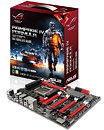
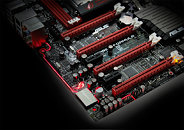
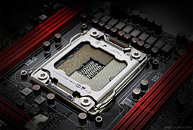

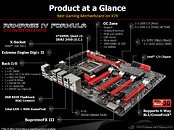
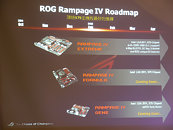
17 Comments on ASUS Ready with Rampage IV Formula; Rampage IV Gene in the Pipeline
:laugh:
I won't be surprised if Intel apes this technique (using blue LEDs) with its next Extreme Board.Anyone notice thin this pic that the Formula and Gene appear to be X58/P67/Z68 boards? definitely don't look like that have the quad channel memory setup with DIMM slots on either side of the CPU socket.
the gene sounds mighty good tho, you could build one honking M-ATX system based on that.
X-Fi MB2 is able to add some "gamer-friendly" audio features to a largely gamer-centric product line that Republic of Gamers is. Whereas Xonar is more of an audiophile and HTPC-centric brand.